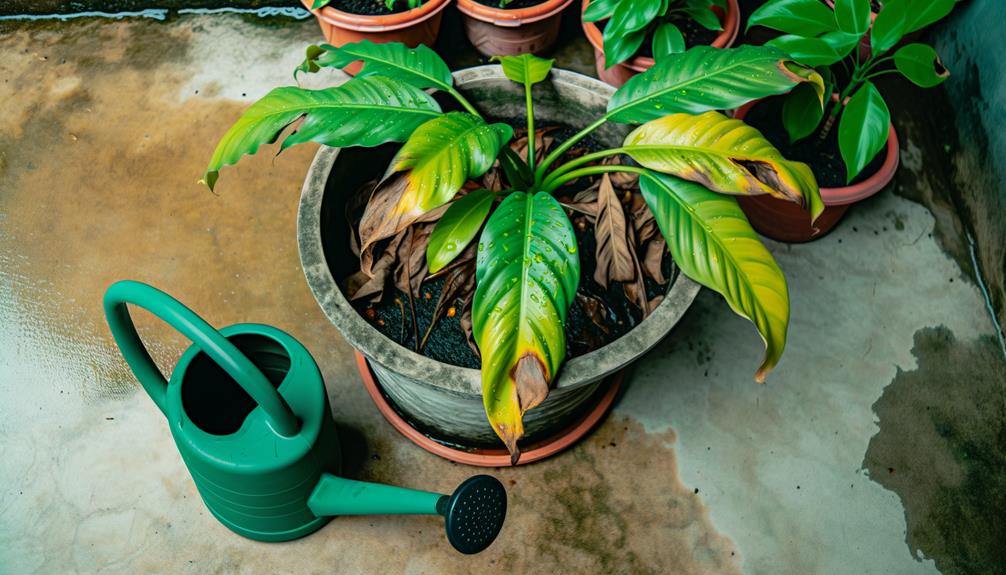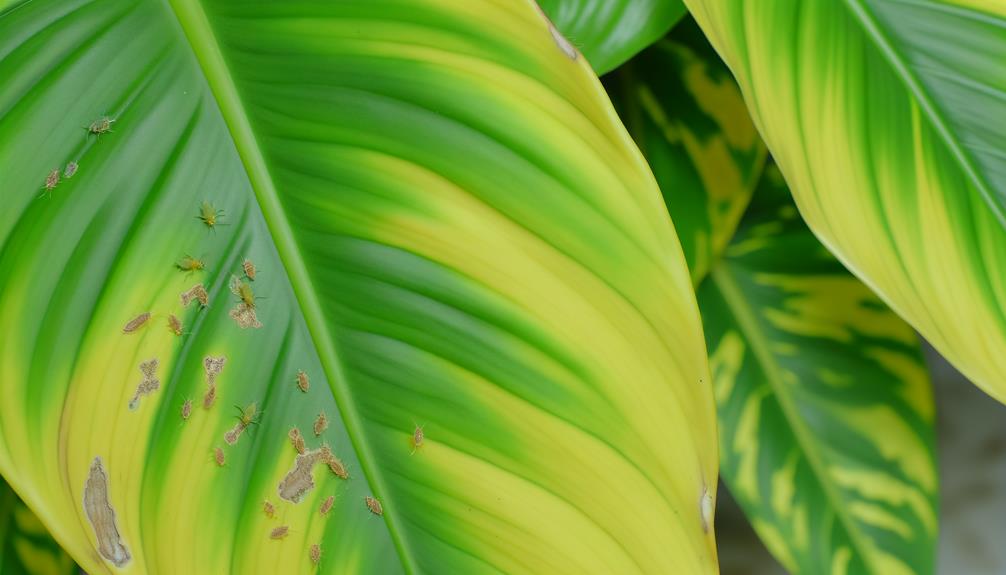Why Does My Philodendron Xanadu Have Yellow Leaves?
Yellow leaves on a Philodendron Xanadu can indicate multiple physiological issues. Overwatering leads to root hypoxia and pathogenic fungal growth, causing yellowing from root rot.
Underwatering results in loss of cellular turgor, chlorosis, and reduced photosynthetic efficiency. Inadequate light impairs chlorophyll synthesis and photosynthetic output.
Nutrient deficiencies, particularly nitrogen, affect chlorophyll production and lead to chlorosis. Pest infestations by aphids, spider mites, and mealybugs extract essential nutrients and promote mold growth.
Temperature stress disrupts cellular metabolism and enzymatic activities, leading to chlorosis. For more detailed insights into these conditions and their management, stay tuned.

Key Takeaways
- Overwatering can cause yellow leaves by disrupting root oxygenation and promoting root rot.
- Underwatering leads to cellular turgor loss, impairing nutrient transport and causing chlorosis.
- Inadequate light hinders photosynthetic efficiency and chlorophyll synthesis, leading to yellowing leaves.
- Nutrient deficiency, particularly nitrogen, results in chlorosis and yellowing foliage.
- Pest infestations, such as aphids or spider mites, extract sap and nutrients, causing leaf yellowing.
Overwatering

Overwatering is a primary cause of yellow leaves in Philodendron Xanadu, as excessive moisture disrupts root oxygenation and promotes pathogenic fungal growth. When the soil remains saturated, the oxygen levels around the root system deplete, leading to hypoxic conditions. This environment is conducive to the proliferation of anaerobic microorganisms, which can cause root rot.
Fungal pathogens such as Pythium and Phytophthora thrive in these conditions, further damaging the roots and impairing their ability to absorb essential nutrients. The compromised root system results in chlorosis, manifesting as yellowing leaves.
Effective management includes ensuring well-draining soil, using pots with drainage holes, and monitoring moisture levels to maintain an ideal balance, thereby preventing the detrimental effects of overwatering.
Underwatering
Inadequate watering leads to dehydration in Philodendron Xanadu, causing cellular turgor loss and subsequent chlorosis, which presents as yellow leaves.
The reduction in water uptake impairs the plant's ability to maintain its intracellular pressure, leading to cellular plasmolysis. Consequently, nutrient transport is hindered, particularly of nitrogen, which is essential for chlorophyll synthesis.
The deficiency in chlorophyll manifests in the yellowing of leaves, known as chlorosis. Prolonged dehydration further exacerbates this condition, resulting in necrosis of leaf tissues.
This physiological stress also triggers the closure of stomata, reducing photosynthetic efficiency and overall plant vigor.
Ensuring consistent and adequate watering schedules mitigates these adverse effects, promoting ideal hydration and nutrient transport essential for maintaining healthy, green foliage.
Inadequate Light

Insufficient light exposure hinders the photosynthetic efficiency of Philodendron Xanadu, resulting in chlorosis and yellowing of the leaves. This plant species requires moderate to bright indirect sunlight to sustain the best photosynthetic activity.
Light deficiency impairs chlorophyll synthesis, reducing the plant's ability to convert light energy into chemical energy, thereby leading to chlorosis—an indication of impaired chloroplast function. Additionally, inadequate light disrupts stomatal conductance, affecting transpiration and nutrient uptake.
Prolonged exposure to subpar light conditions can worsen this stress, culminating in the senescence of foliage. Ensuring appropriate light levels is crucial; placement near east or north-facing windows or utilization of artificial grow lights can mitigate these adverse effects, thereby preserving the plant's physiological health and aesthetic appeal.
Nutrient Deficiency
Nutrient deficiency, especially the absence of nitrogen, can result in chlorosis, manifesting as yellowing leaves in Philodendron Xanadu. Additionally, poor soil quality hinders nutrient uptake, worsening the deficiency symptoms.
Analyzing soil composition and adjusting fertilization practices are essential for maintaining ideal plant health and preventing further discoloration.
Lack of Nitrogen
A deficiency in nitrogen impairs chlorophyll synthesis, which is essential for the photosynthetic process in Philodendron Xanadu, consequently leading to the yellowing of leaves. Nitrogen is a critical macronutrient, and its scarcity disrupts metabolic functions within the plant. This disruption manifests in chlorosis, where leaves exhibit a yellow hue due to inadequate chlorophyll.
To diagnose and address nitrogen deficiency, consider the following steps:
- Soil Testing: Conduct a thorough soil analysis to determine nitrogen levels.
- Fertilization: Apply a balanced, nitrogen-rich fertilizer based on soil test results.
- Organic Matter: Incorporate organic materials such as compost to enhance nitrogen availability.
- Regular Monitoring: Continuously observe leaf color and growth patterns to gauge the effectiveness of interventions.
Poor Soil Quality
Degraded soil quality, characterized by unbalanced pH levels, inadequate nutrient content, and weak soil structure, hampers the health and strength of Philodendron Xanadu, often resulting in chlorotic symptoms such as yellowing leaves.
Unbalanced pH levels can impede nutrient uptake, while a deficiency in essential macronutrients like nitrogen, phosphorus, and potassium further exacerbates the plant's stress. Additionally, micronutrients such as iron, magnesium, and manganese are crucial for chlorophyll synthesis and overall metabolic functions.
Poor soil structure affects root aeration and water retention, limiting nutrient absorption. Regular soil testing, amendment with organic matter, and appropriate fertilization can mitigate these issues, ensuring an ideal growing environment for Philodendron Xanadu and preventing yellowing foliage.
Pest Infestations

Although Philodendron Xanadu is generally resilient, pest infestations can greatly contribute to the yellowing of its leaves by disrupting the plant's physiological functions. Common pests include aphids, spider mites, and mealybugs, which extract sap and essential nutrients, leading to chlorosis. Additionally, pest excretions can foster mold growth, further exacerbating leaf discoloration.
Identifying pest infestations involves:
- Examining for visible insects or their residues on the leaf undersides.
- Spotting any web-like structures, particularly indicative of spider mites.
- Surveying sooty mold or a sticky substance, often left by aphids or mealybugs.
- Verifying for distorted or stunted growth, which may signal prolonged pest activity.
Effective pest management is essential for maintaining the plant's health and preventing further yellowing of leaves.
Temperature Stress
Temperature stress is an important factor that can induce chlorosis in Philodendron Xanadu by disrupting its cellular metabolism and physiological processes. Exposure to temperatures outside the best range of 65-75°F can impair enzymatic activities essential for chlorophyll synthesis.
Elevated temperatures accelerate transpiration rates, leading to water deficits that compromise nutrient uptake. Conversely, low temperatures can inhibit photosynthetic efficiency by affecting thylakoid membrane fluidity and reducing electron transport chain activity. Prolonged exposure to suboptimal temperatures can also induce oxidative stress, generating reactive oxygen species (ROS) that damage cellular components.
Consequently, temperature fluctuations, both acute and chronic, can precipitate yellowing of leaves, signifying a decline in the plant's overall health and strength. Monitoring and maintaining consistent temperature conditions are important for preventing such stress.
Conclusion
The yellowing of Philodendron Xanadu leaves can be likened to a distress signal, indicative of underlying physiological and environmental imbalances. Excessive or insufficient watering disrupts root oxygenation and nutrient uptake.
Less than ideal light conditions impair photosynthetic efficiency, while nutrient deficiencies hinder metabolic processes. Pest infestations and temperature stress further exacerbate foliar discoloration.
Remediation necessitates a holistic approach, addressing these multifaceted factors to restore the plant's verdant essentiality. Understanding these variables guarantees plant health and longevity.






